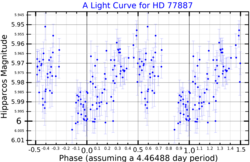
Summary
HD 77887 (HR 3610) is a solitary star located in the southern circumpolar constellation Volans. It has an apparent magnitude of 5.87,[3] making it faintly visible to the naked eye if viewed under ideal conditions. The star is situated at a distance of about 760 light years[2] but is receding with a heliocentric radial velocity of 12.6 km/s.[8]
| Observation data Epoch J2000.0 Equinox J2000.0 (ICRS) | |
|---|---|
| Constellation | Volans |
| Right ascension | 09h 01m 08.5140s[2] |
| Declination | −68° 41′ 02.1096″[2] |
| Apparent magnitude (V) | 5.87±0.01[3] |
| Characteristics | |
| Evolutionary stage | AGB[4] |
| Spectral type | M1 III[5] |
| U−B color index | +1.96[6] |
| B−V color index | +1.63[6] |
| Variable type | Lb[7] |
| Astrometry | |
| Radial velocity (Rv) | 12.6±0.4[8] km/s |
| Proper motion (μ) | RA: +16.413[2] mas/yr Dec.: −0.069[2] mas/yr |
| Parallax (π) | 4.2938 ± 0.051 mas[2] |
| Distance | 760 ± 9 ly (233 ± 3 pc) |
| Absolute magnitude (MV) | −0.78[9] |
| Details[10] | |
| Mass | 1.12[11] M☉ |
| Radius | 56.73 R☉ |
| Luminosity | 598 L☉ |
| Surface gravity (log g) | 0.9 cgs |
| Temperature | 3,820 K |
| Other designations | |
| Database references | |
| SIMBAD | data |
HD 77887 is an ageing M-type giant[5] that is currently on the asymptotic giant branch.[4] At present it has 1.12 times the mass of the Sun[11] but has expanded to 56.73 times its girth.[10] It shines at 598 L☉ from its enlarged photosphere at an effective temperature of 3,820 K,[10] which gives it a red glow. HD 77887 is suspected to be a slow irregular variable[7] whose brightness fluctuates at a tenth of a magnitude.[12] Koen and Eyer examined the Hipparcos data for the star, and found that it varied periodically, with an amplitude of 0.012 magnitudes, and a period of 4.4649 days.[13]
References edit
- ^ "Light Curve". Hipparcos ESA. ESA. Retrieved 11 October 2022.
- ^ a b c d e f Brown, A. G. A.; et al. (Gaia collaboration) (2021). "Gaia Early Data Release 3: Summary of the contents and survey properties". Astronomy & Astrophysics. 649: A1. arXiv:2012.01533. Bibcode:2021A&A...649A...1G. doi:10.1051/0004-6361/202039657. S2CID 227254300. (Erratum: doi:10.1051/0004-6361/202039657e). Gaia EDR3 record for this source at VizieR.
- ^ a b Høg, E.; Fabricius, C.; Makarov, V. V.; Urban, S.; Corbin, T.; Wycoff, G.; Bastian, U.; Schwekendiek, P.; Wicenec, A. (March 2000). "The Tycho-2 catalogue of the 2.5 million brightest stars". Astronomy and Astrophysics. 355: L27–L30. Bibcode:2000A&A...355L..27H. ISSN 0004-6361.
- ^ a b Eggen, Olin J. (July 1992). "Asymptotic giant branch stars near the sun". The Astronomical Journal. 104: 275. Bibcode:1992AJ....104..275E. doi:10.1086/116239. ISSN 0004-6256.
- ^ a b Houk, N.; Cowley, A. P. (1975). University of Michigan Catalogue of two-dimensional spectral types for the HD stars. Volume I. Declinations -90_ to -53_ƒ0. Bibcode:1975mcts.book.....H.
- ^ a b Johnson, H. L.; Mitchell, R. I.; Iriarte, B.; Wisniewski, W. Z. (1 January 1966). "UBVRIJKL Photometry of the Bright Stars". Communications of the Lunar and Planetary Laboratory. 4: 99–110. Bibcode:1966CoLPL...4...99J.
- ^ a b Jayasinghe, T; Kochanek, C S; Stanek, K Z; Shappee, B J; Holoien, T W-S; Thompson, Toda A; Prieto, J L; Dong, Subo; Pawlak, M; Shields, J V; Pojmanski, G; Otero, S; Britt, C A; Will, D (1 July 2018). "The ASAS-SN catalogue of variable stars I: The Serendipitous Survey". Monthly Notices of the Royal Astronomical Society. 477 (3): 3145–3163. arXiv:1803.01001. Bibcode:2018MNRAS.477.3145J. doi:10.1093/mnras/sty838. ISSN 0035-8711.
- ^ a b Gontcharov, G. A. (November 2006). "Pulkovo Compilation of Radial Velocities for 35 495 Hipparcos stars in a common system". Astronomy Letters. 32 (11): 759–771. arXiv:1606.08053. Bibcode:2006AstL...32..759G. doi:10.1134/S1063773706110065. ISSN 1063-7737. S2CID 119231169.
- ^ Anderson, E.; Francis, Ch. (May 2012). "XHIP: An extended hipparcos compilation". Astronomy Letters. 38 (5): 331–346. arXiv:1108.4971. Bibcode:2012AstL...38..331A. doi:10.1134/S1063773712050015. ISSN 1063-7737. S2CID 255204555.
- ^ a b c McDonald, I.; Zijlstra, A. A.; Watson, R. A. (2017). "Fundamental parameters and infrared excesses of Tycho-Gaia stars". Monthly Notices of the Royal Astronomical Society. 471 (1): 770. arXiv:1706.02208. Bibcode:2017MNRAS.471..770M. doi:10.1093/mnras/stx1433.
- ^ a b Anders, F.; et al. (1 August 2019). "Photo-astrometric distances, extinctions, and astrophysical parameters for Gaia DR2 stars brighter than G = 18". Astronomy and Astrophysics. 628: A94. arXiv:1904.11302. Bibcode:2019A&A...628A..94A. doi:10.1051/0004-6361/201935765. ISSN 0004-6361. S2CID 131780028.
- ^ Watson, C. L.; Henden, A. A.; Price, A. (May 2006). "The International Variable Star Index (VSX)". Society for Astronomical Sciences Annual Symposium. 25: 47. Bibcode:2006SASS...25...47W.
- ^ Koen, Chris; Eyer, Laurent (March 2002). "New periodic variables from the Hipparcos epoch photometry". Monthly Notices of the Royal Astronomical Society. 331 (1): 45–59. arXiv:astro-ph/0112194. Bibcode:2002MNRAS.331...45K. doi:10.1046/j.1365-8711.2002.05150.x. S2CID 10505995.



